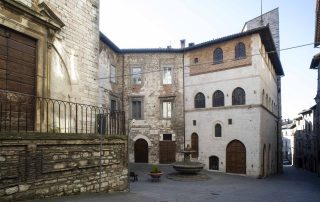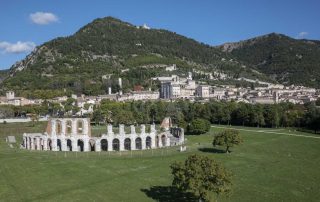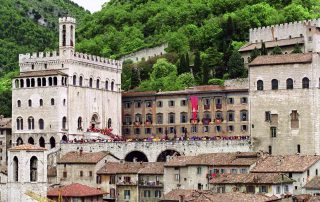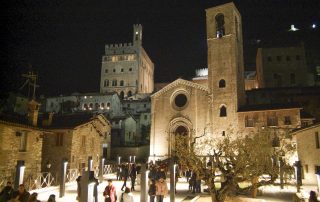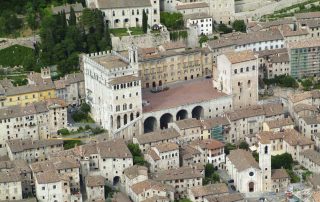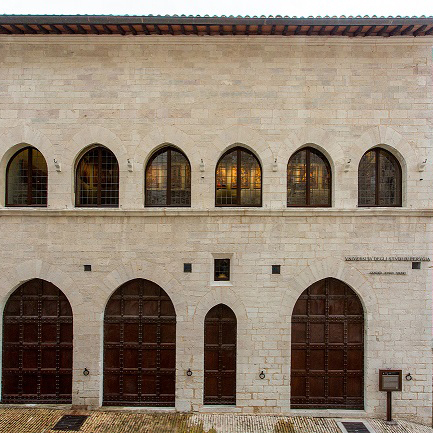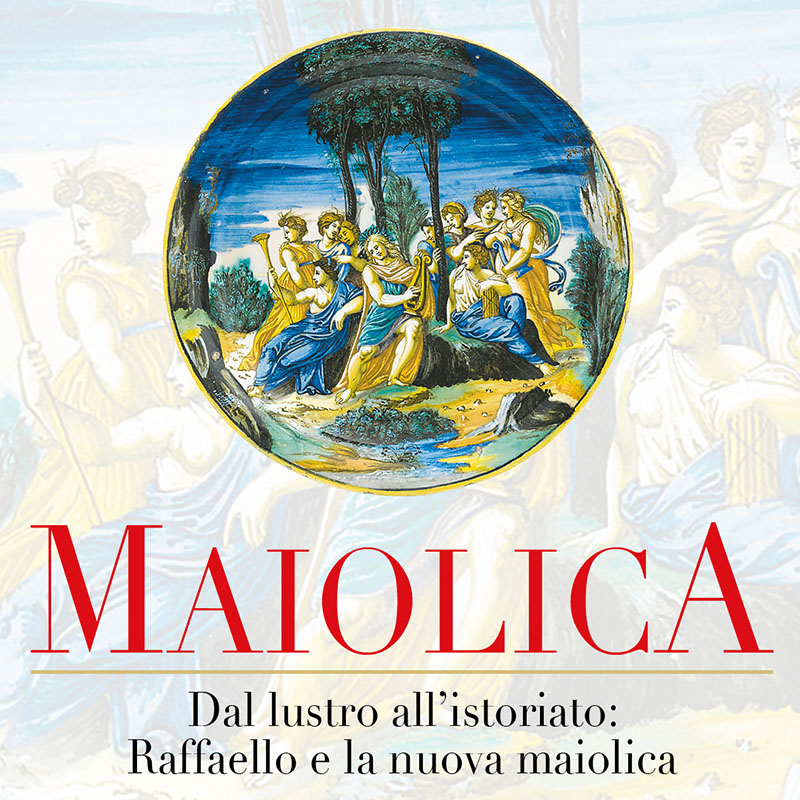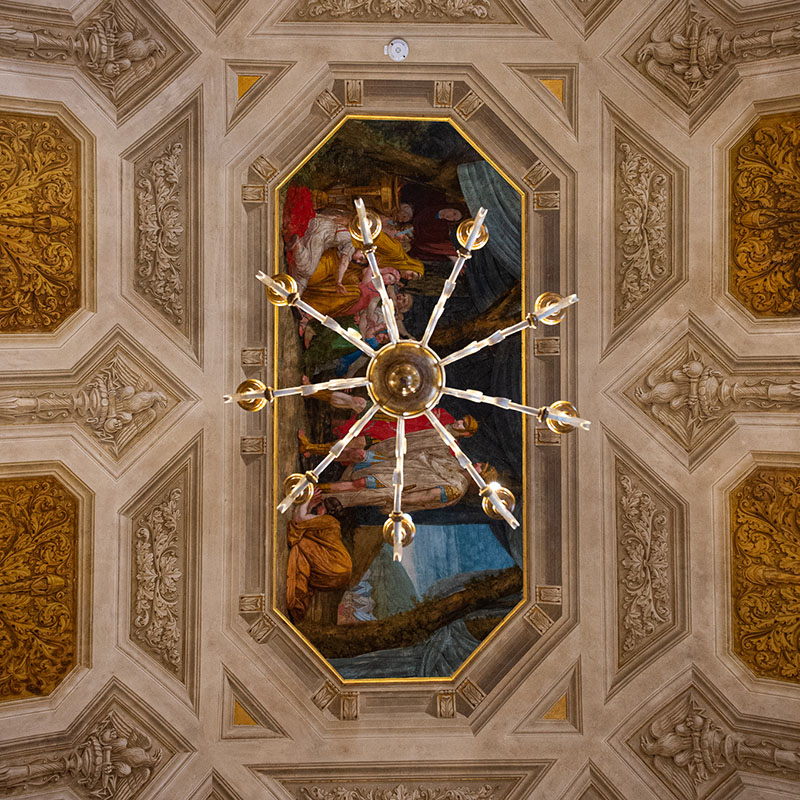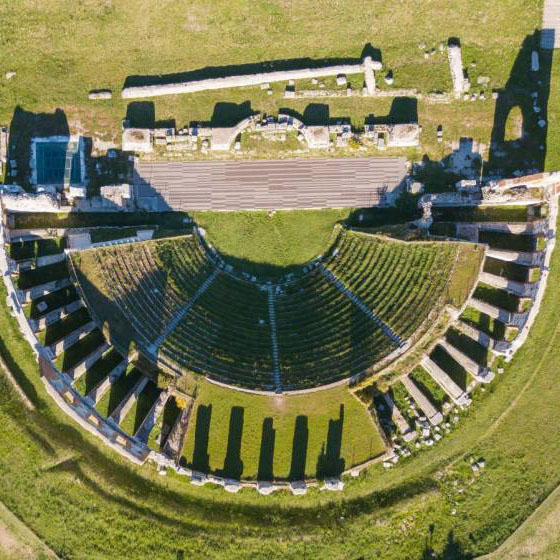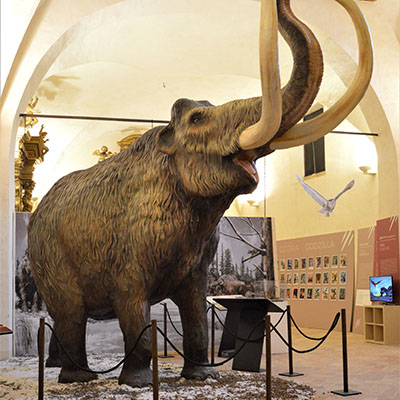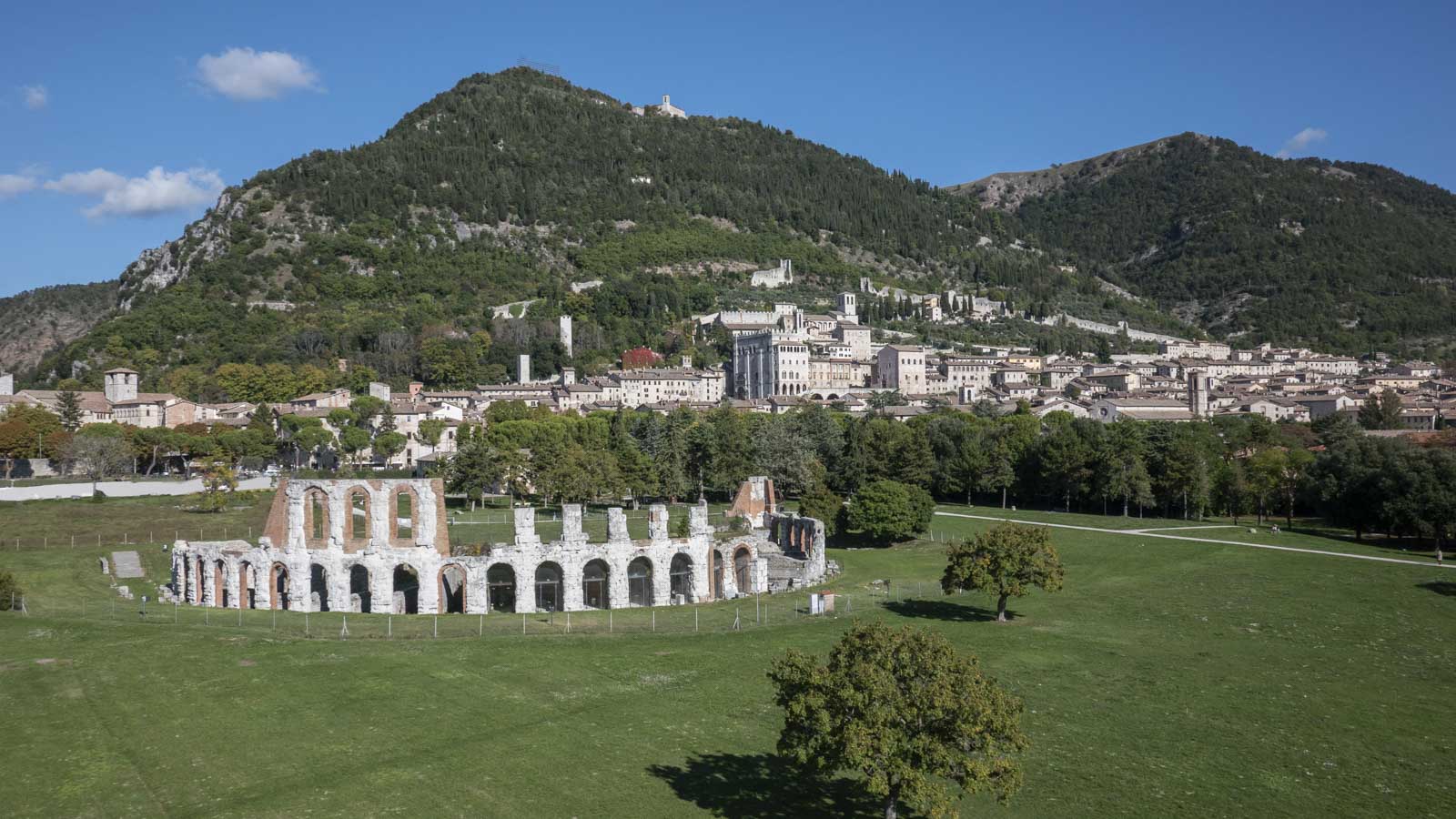
GALLERY
THE CITY
Gubbio stands at the foot of Mount Ingino occupying a dominant and scenic position in an elongated valley which backs onto the ridge of the Apennines and is surrounded by a remarkable natural landscape alternating lowland with hills and mountains. The territory is extensive, criss-crossed by a dense network of highways and country roads and notable for the presence of fortresses, castles, churches, monasteries and abbeys. Gubbio (Ikuvium)is among the oldest towns in Umbria, and was a major centre of the Ancient Umbrian civilisation, as testified by the famous Iguvine Tables. In 90 BCE it became a flourishing Roman municipium (provincial city) whose monumental theatre can still be admired as well as the remains of Roman houses, beautifully decorated with mosaics, and also rich sets of funerary objects found in the necropolis scattered throughout the territory. In 552 CE, the town was destroyed by Totila’s Goths and subsequently was subject firstly to Byzantine domination and then to that of the Lombards. It declared itself a Free Commune in the twelfth century under the spiritual guidance of Bishop Ubaldo, the government being exercised by the Consuls who were later assisted by the Capitano del Popolo and the Podestà. It was to achieve the height of its splendour in the thirteenth and fourteenth centuries when it assumed the typical medieval aspect that still characterises it today. The cross-shaped layout of the town divides it into four civic districts, and its uphill development renders every part of the historic centre clearly visible, highlighting the principal monuments in a marvellously scenic panorama. At its heart stands the magnificent fourteenth century architectural complex of Piazza Grande, the breathtaking suspended square at whose extremities stand the civic buildings, symbolising the Communal Government: the Palazzo del Podestà, now the principal seat of the Municipal Authority and the Palazzo dei Consoli, which now houses the Civic Museum. The latter is an imposing and elegant building with its characteristic crenellated battlements and bell tower, and soars above the town from its height of 60 metres, impressing its image forever in the memory of every visitor. Further uphill, are to be found the seats of religious power, the Cathedral, dedicated to Saints Mariano and Giacomo and the Palazzo dei Canonici, now the Diocesan Museum both of which were built between the end of the twelfth century and the beginning of the thirteenth. These buildings with their severe Gothic outlines and rich interiors constitute the town’s acropolis together with the Palazzo Ducale, one-time residence of the Counts and Dukes of Urbino who held sway over Gubbio from 1384 to 1631. Federico da Montefeltro commissioned the architect, Francesco di Giorgio Martini, to build the Palace, which was constructed between 1474 and 1482 and represents the highpoint of Renaissance art in Gubbio. In the Communal Period, the Mendicant Orders and various charitable Confraternities founded communities in the town, constructing a number of churches and other buildings which further defined the architectural appearance of the town, and also led to the commissioning of important artworks. The church of San Francesco was erected on the place where St. Francis received his mendicant’s habit, and, together with the homonymous Convento, occupies part of what was once the Campus Mercatalis (Market Square) and is now Piazza Quaranta Martiri. The remaining space in the square is taken up by the usually animated Public Gardens, laid out in the 19th century, the Church of Santa Maria dei Laici and by the Loggia dei Tiratori. This long building with its characteristic portico was originally the hospital of Santa Maria della Misericordia, built in 1326 by the Confraternity of the same name. The upper floor gallery was added by the wool merchant’s guild in the 17th century and used for stretching out the lengths of dyed woollen cloth to dry. Behind this lies the district of San Giuliano and through the openings in the gallery one can glimpse the beautiful façade of the Church of San Giovanni with its ponderous quadrangular bell tower alongside it. To the north-west, in the middle of the district of San Martino, stands the Church of San Domenico, renowned for the exquisite carving and marquetry of its choir stalls, a masterpiece of Renaissance art… The Church of Sant’Agostino, in the suburb of the same name, lies just outside the city walls beyond the district of Sant’Andrea and defines the eastern outline of the town. The church is famous for its fifteenth century frescoes by Ottaviano Nelli and nearby, in the Church of Santa Maria Nuova, there is another major work by the artist, The Belvedere Madonna, one of the best examples of International Gothic in Umbria. Further to the South, the distinguishing feature of the panorama consists of the church and ex-monastery belonging to the ancient Benedictine Abbey of San Pietro, located in the district of the same name, which was subsequently modified in the sixteenth century. There are several places of worship which preserve the memory of St. Francis and his message; besides the Church of St. Francis, which is the third most important Franciscan shrine in Umbria, there is the little church called the Vittorina which lies outside the city walls along the ancient route between Gubbio and Assisi on the site of the famous episode of St. Francis’s encounter with the Wolf of Gubbio, as told in The Little Flowers of St. Francis. There is also the Church of San Francesco della Pace, in the town centre, which contains the grotto where the tamed wolf lived and the sepulchre where it was buried. Of particular interest are the city walls which were built at the end of the thirteenth century and follow exactly, in the uppermost section, the line of the Ancient Umbrian walls. They form a complete circuit around the town and still preserve six of the original twelve gateways. One can also take an agreeable and picturesque two- kilometre walk along the medieval aqueduct which winds its way from the city walls across the western slopes of Mount Ingino alongside the Bottaccione Ravine. This site is of great historic and environmental interest and of international scientific importance due to the presence of sedimentary rocks spanning a geological time-scale of more than one hundred million years, ranging from the Jurassic to the Tertiary Periods. On the opposite flank of the mountain, there is an unusual cableway which in a few minutes rises to the summit of the mountain where the Basilica of Sant’Ubaldo is located, inside which the Ceri are preserved. From up here the panorama is really complete because besides offering an extensive view of the town and the valley, the Apennine chain is also visible from the Rocca.

